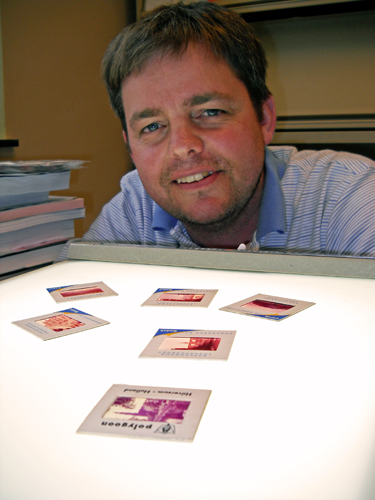
Those faded old photographic slides tucked away in your basement might have new life yet. U of G computer scientists have developed a better formula for restoring timeworn and damaged slides to make digital copies whose colours look more like the real thing.
Their method isn’t perfect. Prof. Michael Wirth, School of Computer Science, says no electronic scanner beats the human eye for judging whether that’s just the right tone of purple in Aunt Marge’s hat or the correct crimson in that favourite childhood bicycle of yours.
But Wirth says the colour restoration algorithm developed by PhD student Denis Nikitenko yields better results than the software in today’s off-the-shelf imaging tools.
Their work might offer a more effective and efficient way to digitally restore photographic slides, from those family snaps squirreled away in countless drawers and closets to historically significant images held in libraries and archival collections.
Eyeing piles of slides stacked atop the tables and desk in his Reynolds Building office, he says, “Everyone has these in their cupboard at home.”
That includes the Guelph computer scientist, who figures he’s got about 500 transparencies taken by his dad during Michael’s youth spent in Australia in the late sixties and early seventies. Those boyhood memories are still tucked away at home, mostly unviewed. “I grew up with slides,” says Wirth, 40, who today relies on his Olympus digital camera to document the life of his eight-year-old daughter.
Those roughly 1,500 slides in his office are ones that he bought during the past year or so on eBay – a “great research resource,” he jokes. Many are Kodak Ektachrome landscapes and cityscapes from around the world, including collections shot by professionals and packaged for sale to tourists during the 1950s, ’60s and ’70s. “You went to Rome and bought a pack of slides.”
Look at a few on his desktop light box, and you immediately see the problem.
Many slides and photographs fade over time as their chemical dyes break down under light, humidity or warm temperatures. Often only certain colours fade, leaving slides that look as though they’d been dipped in blue or red food colouring.
Wirth says many people like to create digital copies of old photos and slides. Galleries, library archives and museums often have drawers’ worth of transparencies that might be restored and shared online. But even modern scanners and computers fail to restore colours true to the originals, says the Guelph professor.
Along with Nikitenko and Kataline Trudel, then a psychology undergrad, he tested existing colour manipulation algorithms that enable scanners and computers to adjust image colours based on light conditions. (The human eye and brain perceive colour naturally under varying light conditions; cameras need white-balancing algorithms to “see” properly.)
In their tests, they asked people to assess restored and undamaged images. Some images restored with existing algorithms were better than others. But none matched people’s perceptions of real-world colours.
For his PhD, co-advised by Prof. Deb Stacey, Nikitenko developed a new colour restoration algorithm from an existing one. Tests found that the new formula worked better, although human observers were still more acute at assessing image colours.
“Anything to do with light and colour is interesting,” says Nikitenko, an amateur photographer and Guelph master’s grad who will defend his doctoral thesis in the fall. Having taught as a sessional lecturer at Sheridan College Institute of Technology and Advanced Learning, he began a faculty position in Sheridan’s school of applied computing and engineering sciences this summer.
Besides the computer science aspect, Wirth says, the project may provide information about anything from geography and landscape to social and historical changes. “I think there’s a lot of information value in old images. What sort of picture do they present of a period when people started to travel?”
Scientists would likely get little useful information out of your relatives’ vacation snaps. But Wirth says an image archive might show changes over those decades, including, say, erosion of an oft-snapped glacier at a popular Alpine retreat.
Wirth came to Guelph in 2000 to study medical imaging. An amateur history buff, he’s also looked at algorithms to improve resolution of old-style composite images from the glass plates and colour filters of photography’s early days. He has also co-authored a paper about photos by Sergei Mikhailovich Prokudin-Gorskii, a colour photography pioneer who travelled the Russian Empire before the First World War collecting thousands of images recorded on glass plates that are now held at the Library of Congress.